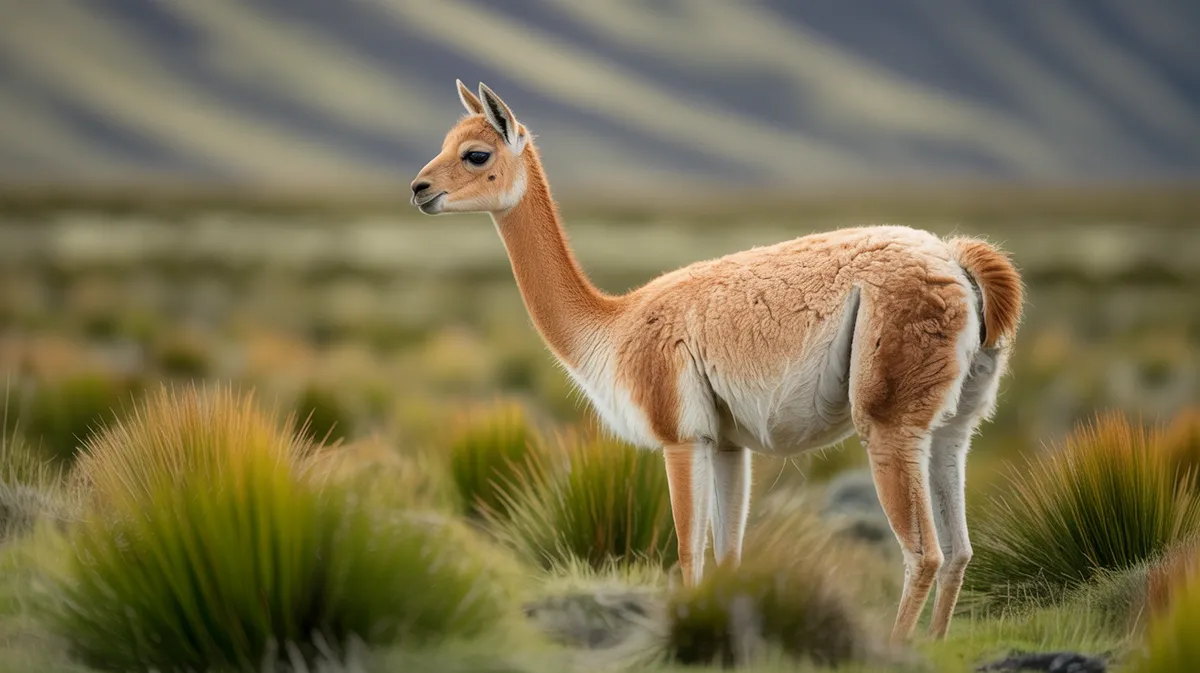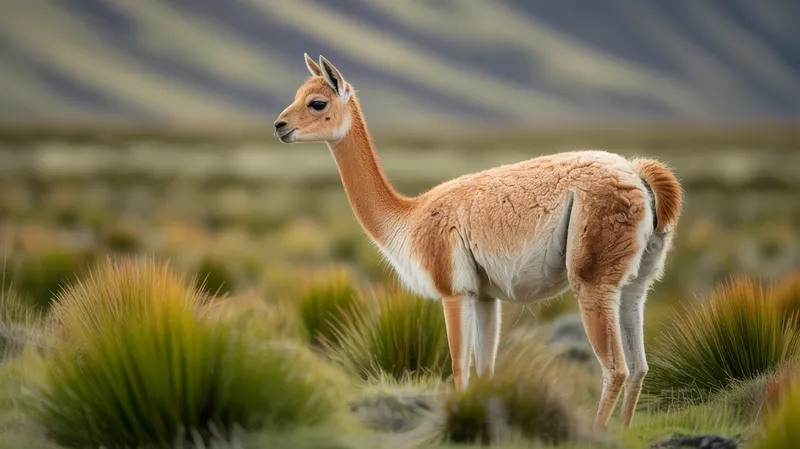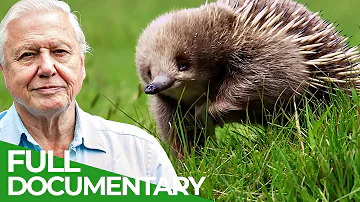
Vicuña
Vicugna vicugna

Meet the Vicuña
The vicuña is a graceful, wild South American camelid native to the high alpine areas of the Andes Mountains. Renowned for its extremely fine and soft wool, the vicuña has a slender build, long neck, and a light brown coat with white underparts. Vicuñas are highly adapted to harsh, cold climates and graze on tough mountain grasses. Once threatened by overhunting for their valuable fleece, they are now protected in many regions, though they remain sensitive to environmental changes. The vicuña is the smallest member of the camelid family and is closely related to the domesticated alpaca.
Classification
Mammal
Habitat
High-altitude grasslands and plains (puna) of the Andes Mountains
Diet
Herbivore
Lifespan
15-20 years
Conservation
Least Concern
Weight
35-65 kg
📖Fascinating Facts
Fleece of Gold
Vicuña wool is so valuable that in ancient Incan society, only royalty were permitted to wear garments made from it.
High-Altitude Adaptation
Vicuñas thrive at elevations between 3,200 to 4,800 meters, where temperatures can drop below freezing.
Family Groups
They live in small family groups led by a dominant male, which fiercely defends its territory from rivals.
📋Detailed Description
The vicuña (Vicugna vicugna) is a small, slender camelid, standing about 80–90 cm at the shoulder and weighing between 35–50 kg. Its body is covered in a dense, cinnamon-brown coat with a white underbelly and inner legs, providing both camouflage and insulation against the harsh Andean climate. The head is small and delicate, with large, expressive eyes and pointed, mobile ears. Adapted to high-altitude environments (3,200–4,800 meters), vicuñas possess a high concentration of red blood cells and an efficient hemoglobin variant, allowing them to thrive in oxygen-poor conditions. Their limbs are long and thin, ending in padded, two-toed feet that provide stability on rocky, uneven terrain. Vicuñas are highly social, living in stable family groups consisting of a dominant male, several females, and their offspring, while bachelor males form separate groups. They are diurnal, spending most of the day grazing on tough, high-altitude grasses and sedges, and are known for their alertness and agility, quickly fleeing from predators. Vicuñas communicate through a variety of vocalizations and body postures, and their keen eyesight helps them detect threats at great distances. The species is renowned for producing the finest natural fiber in the world, with individual fibers measuring just 12 microns in diameter.
💡 Did you know?
Vicuñas can only be shorn once every two to three years, and each animal produces just about 0.5 kg of wool per shearing.
🔬Research & Sources
Wikipedia Summary
The vicuña or vicuna is one of the two wild South American camelids, which live in the high alpine areas of the Andes; the other camelid is the guanaco, which lives at lower elevations. Vicuñas are relatives of the llama, and are now believed to be the wild ancestor of domesticated alpacas, which are raised for their coats. Vicuñas produce small amounts of extremely fine wool, which is very expensive because the animal can be shorn only every three years and has to be caught from the wild. When knitted together, the product of the vicuña's wool is very soft and warm. The Inca valued vicuñas highly for their wool, and it was against the law for anyone but royalty to wear vicuña garments; today, the vicuña is the national animal of Peru and appears on the Peruvian coat of arms.
Last Modified: 6/9/2025
🎭Behavior & Social Structure
Vicuñas exhibit complex social structures, with family groups typically comprising one territorial male and up to 10 females with their young. The dominant male is responsible for defending the territory, which can range from 18 to 150 hectares, marking boundaries with dung piles. Bachelor groups, consisting of non-territorial males, are common and may serve as a reservoir for future territorial males. Vicuñas are primarily grazers, feeding on short, tough grasses and forbs found in the puna ecosystem. They graze during the day, especially in the early morning and late afternoon, and rest in open areas to maintain vigilance against predators such as pumas and Andean foxes. Social interactions include grooming, vocalizations (including alarm calls and whistles), and ritualized displays of dominance or submission. Group cohesion is maintained through frequent contact and coordinated movement, with the dominant male often leading the group to new grazing areas.
👶Reproduction & Life Cycle
Vicuñas are seasonal breeders, with mating occurring from March to May. The dominant male mates with the females in his group, aggressively excluding rival males. After a gestation period of approximately 330–350 days, females give birth to a single cria (young) between February and April, coinciding with the rainy season when food is most abundant. Births typically occur during daylight hours in open areas to reduce predation risk. Newborns are precocial, standing and walking within an hour of birth, and are nursed for about 10 months. Females provide the primary parental care, while males protect the group. Juveniles are expelled from the family group at 12–18 months, with males joining bachelor groups and females forming new family units or joining existing ones.
🛡️Adaptations & Survival
Vicuñas have evolved several adaptations for survival in the extreme Andean environment. Their wool is exceptionally fine and dense, providing insulation against cold temperatures and strong winds. The unique structure of their hemoglobin allows efficient oxygen uptake at high altitudes. Their large lungs and heart further enhance oxygen transport. Behavioral adaptations include diurnal activity patterns to avoid nighttime cold and coordinated group vigilance to detect predators. Their padded feet reduce heat loss and provide traction on rocky slopes. Vicuñas also have a low metabolic rate, enabling them to survive on sparse, nutrient-poor vegetation.
🎨Cultural Significance
The vicuña has held immense cultural and economic significance in Andean societies for millennia. Revered by the Inca civilization, vicuñas were considered sacred, and their wool was reserved exclusively for royalty. Traditional chaccu roundups, in which wild vicuñas are herded, shorn, and released, continue today as a sustainable practice and cultural event in Peru and Bolivia. The animal is a national symbol of Peru, featured on the coat of arms and currency, and represents the value of biodiversity and conservation. Vicuña wool remains one of the most valuable natural fibers globally, prized for its softness, warmth, and rarity.
🔬Recent Research & Discoveries
Recent genetic studies have confirmed that the vicuña is the wild ancestor of the domesticated alpaca, clarifying the evolutionary relationships among South American camelids. Ongoing research focuses on population genetics, disease resistance, and the impact of climate change on high-altitude ecosystems. Conservation programs emphasize community involvement, sustainable fiber harvesting, and habitat restoration. Studies on vicuña social behavior and communication have provided insights into the evolution of complex social systems in ungulates. There is also increasing interest in the physiological mechanisms underlying their adaptation to hypoxic environments.
🎥Wildlife Videos

Vicuña Salvation - The greatest wildlife conservation story never told.
Vicuña Salvation tells the incredible fight for survival of the vicuña population in Peru. Vicuñas were brought back from the brink of ...
Quechua Benefit

David Attenborough Presents: Tasmania - Weird & Wonderful | Free Documentary Nature
David Attenborough presents: Tasmania - Weird & Wonderful | Wildlife Documentary Watch 'David Attenborough's Ant Mountain' ...
Free Documentary - Nature

Wildlife - The Fascinating World of Wild Animals | Full Series | Free Documentary Nature
Wildlife - The Fascinating World of Wild Animals | Wildlife Documentary Watch 'Ocean Stories - Full Series' here: ...
Free Documentary - Nature

Wild Canada - Nature's Untamed Beauty | Full Series | Free Documentary Nature
Wild Canada - Nature's Untamed Beauty | Wildlife Documentary Watch 'Darkwoods - Canada's Hidden Nature Reserve' here: ...
Free Documentary - Nature

Wild Colombia - Fantastic Creatures | The Lost Eden | Free Documentary Nature
Wild Colombia - Fantastic Creatures | The Lost Eden | Free Documentary Nature Watch 'Wild Colombia Revealed' here: ...
Free Documentary - Nature

Andean Mountain Wildlife in 4K: Vicuña Baby | Nature Relaxation Instrumental Documentary
Filmed by David Huting on the Canon 1DC in 4K UHD. The timing of getting this shot was incredible, as I was on a full day tour ...
Nature Relaxation Films
🌍Habitat Information
The Vicuña typically inhabits High-altitude grasslands and plains (puna) of the Andes Mountains environments. Vicuñas have adapted to their environments with specialized features and behaviors.
Primary Habitat:
High-altitude grasslands and plains (puna) of the Andes Mountains
More detailed habitat information will be available soon.
🛡️Conservation Status
The Vicuña is currently classified as Least Concern. Conservation efforts are crucial for preserving this species for future generations.
Common Threats:
- 🏠Habitat loss and fragmentation
- 🌡️Climate change impacts
- 🎯Hunting and poaching
- 🏭Human-wildlife conflict
⚠️Threats & Conservation Challenges
Historically, vicuñas faced severe population declines due to overhunting for their prized wool, with numbers dropping below 10,000 by the mid-20th century. Intensive conservation efforts, including legal protection and community-based management, have led to a remarkable recovery, with current estimates exceeding 350,000 individuals. However, threats persist, including illegal poaching, habitat degradation from overgrazing by livestock, climate change, and genetic bottlenecks in isolated populations. The species is currently listed as 'Least Concern' by the IUCN, but ongoing monitoring and sustainable management are essential to prevent future declines.
🔬Scientific Classification
Scientific Name
Vicugna vicugna
Classification Hierarchy
🔍 About Taxonomic Classification
Taxonomic classification is a hierarchical system used by scientists to classify and organize living organisms based on shared characteristics and evolutionary relationships.
The system moves from broad categories (Kingdom) to increasingly specific ones, with each animal's scientific name typically consisting of its Genus and species.
📝Community Notes
Share your observations and insights about the Vicuña with our community of wildlife enthusiasts.
Join Our Community
Sign in to share your observations and connect with fellow wildlife enthusiasts.
Sign In to ContributeNo community notes yet
Be the first to share your observations about the Vicuña!
Explore Vicuña
Select a tab above to learn more about this amazing animal.
📸Photo Gallery
No photos available for this animal yet.
🌟Discover More Wildlife
Continue your journey of discovery with more fascinating animals from our database
